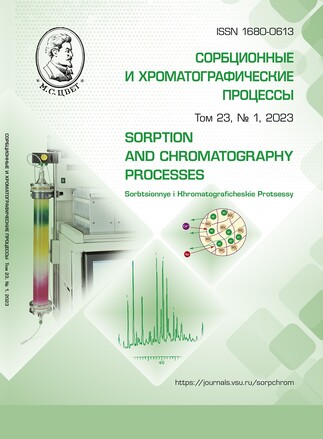Determination of hydrogen sulfide in the air with a semiconductor sensor based on indium oxide
Abstract
Hydrogen sulphide is a toxic gas that can get into the air during the extraction of oil and natural gas, in metallurgical industries, as well as during the storage and processing of man-made and household waste. Determination of hydrogen sulphide in the atmosphere is an urgent task of analytical chemistry. For the continuous monitoring of hydrogen sulphide content in low-accessibility areas, such well-known methods as chromatography or mass spectrometry are not suitable, therefore, a practical task of the production of an inexpensive chemical sensor with sufficiently high sensitivity and selectivity appeared. In our study, we synthesized gas sensitive materials based on In2O3 with catalytic additives – palladium (which is contained mainly in the form of PdO) and silver (mainly in the form of Ag2O). The synthesis was carried out in several stages, the first stage included the preparation of In(OH)3 sol. After centrifugation, the heat treatment of indium hydroxide was carried out, as a result of which indium oxide nanopowder was obtained. The resulting material was characterized by transmission electron microscopy and X-ray phase analysis. Subsequently, the indium oxide nanopowder was mixed with catalytic additives and a binder to form a paste. The gas-sensitive material was obtained by annealing of the paste at a temperature of 750оС.
The sensory properties of gas-sensitive materials with respect to hydrogen sulphide and carbon monoxide under non-stationary temperature conditions - heating to a temperature of 450оС for 2 seconds and cooling to a temperature of 100оС for 13 seconds were investigated. It was shown that materials based on nanodispersed indium oxide have a high sensitivity to hydrogen sulphide, as well as high selectivity.
Downloads
References
Guidotti, T.L. Hydrogen sulfide: Advances in understanding human toxicity. Int. J. Toxicol. 2010; 29: 569-581.
Maekawa T. et al. Sensing Behavior of CuO-Loaded SnO2 Element for H2S Detection. Chemistry Letters. 1991; 20(4): 575-578.
Tamaki J. et al. CuO-SnO2 element for highly sensitive and selective detection of H2S. Sensors Actuators B. Chem. 1992; 9(3): 197-203.
Choi S.W. et al. H2S sensing performance of electrospun CuO-loaded SnO2 nanofibers. Sensors Actuators, B Chem. 2012; 169: 54-60.
Zhao Y. et al. Porous CuO/SnO2 composite nanofibers fabricated by electrospinning and their H2S sensing properties. Sensors Actuators, B Chem. 2012; 165(1): 82-87.
Shao F. et al. Heterostructured p-CuO (nanoparticle)/n-SnO2 (nanowire) devices for selective H2S detection. Sensors Actuators, B Chem. 2013; 181: 130-135.
Hwang I.S. et al. Enhanced H2S sensing characteristics of SnO2 nanowires functionalized with CuO. Sensors Actuators, B Chem. 2009; 142(1): 105-110.
Katti V.R. et al. Mechanism of drifts in H2S sensing properties of SnO2:CuO composite thin film sensors prepared by thermal evaporation. Sensors Actuators, B Chem. 2003; 96(1-2): 245-252.
Choi K. Il et al. Ultraselective and ultrasensitive detection of H2S in highly humid atmosphere using CuO-loaded SnO2 hollow spheres for real-time diagnosis of halitosis. Sensors Actuators, B Chem. 2014; 194: 371-376.
Verma M.K., Gupta V. A highly sensitive SnO2-CuO multilayered sensor structure for detection of H 2S gas. Sensors Actuators, B Chem. 2012; 166-167: 378-385.
Vasiliev R.B. et al. Effect of interdiffusion on electrical and gas sensor properties of CuO/SnO2 heterostructure. Mater. Sci. Eng. B. 1999; 57(3): 241-246.
Vasiliev R.B. et al. CuO/SnO2 thin film heterostructures as chemical sensors to H2S. Sensors Actuators, B Chem. 1998; 50 B50(3); 186-193.
Malyshev V.V., Pislyakov A.V. SnO2-based thick-film-resistive sensor for H2S detection in the concentration range of 1-10 mg m-3. Sensors Actuators, B Chem. 1998; 47(1-3): 181-188.
Lantto V., Mizsei J. H2S monitoring as an air pollutant with silver-doped SnO2 thin-film sensors. Sensors Actuators B. Chem. 1991; 5(1-4): 21-25.
Harkoma-Mattila A. et al. Sensitivity and selectivity of doped SnO2 thick-film sensors to H2S in the constant- and pulsed-temperature modes. Sensors Actuators B. Chem. 1992; 6(1-3): 248-252.
Gong J. et al. Micromachined nanocrystalline silver doped SnO2 H2S sensor. Sensors Actuators, B Chem. 2006; 114(1): 32-39.
Ngoc T.M. et al. Self-heated Ag-decorated SnO2 nanowires with low power consumption used as a predictive virtual multisensor for H2S-selective sensing. Anal. Chim. Acta. 2019; 1069: 108-116.
Kolhe P.S. et al. Synthesis of Ag doped SnO2 thin films for the evaluation of H2S gas sensing properties. Phys. B Condens. Matter. 2017; 524(June): 90-96.
Song B.Y. et al. Highly selective ppb-level H2S sensor for spendable detection of exhaled biomarker and pork freshness at low temperature: Mesoporous SnO2 hierarchical architectures derived from waste scallion root. Sensors Actuators, B Chem. 2020; 307(December 2019): 127662.
Sberveglieri G. et al. Detection of sub-ppm H2S concentrations by means of SnO2(Pt) thin films, grown by the RGTO technique. Sensors Actuators B. Chem. 1993; 15(1-3): 86-89.
Keshtkar S. et al. A novel highly sensitive and selective H2S gas sensor at low temperatures based on SnO2 quantum dots-C60 nanohybrid: Experimental and theory study. Talanta. 2018; 188: 531-539.
Hu X. et al. Highly sensitive H2S gas sensors based on Pd-doped CuO nanoflowers with low operating temperature. Sensors Actuators, B Chem. 2017; 253: 809-817.
Hu Q. et al. Binder-free CuO nanoneedle arrays based tube-type sensor for H2S gas sensing. Sensors Actuators, B Chem. 2021; 326(June 2020): 128993.
Shaposhnik A. et al. Selective detection of hydrogen sulfide and methane by a single MOX-sensor. Sensors (Switzerland). 2019; 19(5): 1135.







